Blog categories
Blog archive
RSS Blog posts tagged with 'tips'
Blog Filters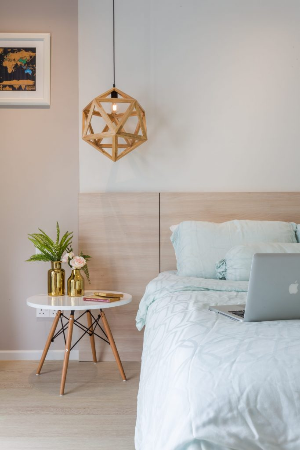
Designer Tips for Creating Beautiful Bedrooms
Friday, November 20, 2020
 Interior design by: Nu Infinity
Interior design by: Nu Infinity
Beauty may be subjective, but there are some factors we can all agree on. Get inspired by these designer ideas to create a cosy and eye-pleasing bedroom.
What is it about Leonardo da Vinci's Mona Lisa that makes it the iconic portrait that we know it as today? Some may point to her enigmatic smile, the detailed background, the possibility of it being a self-portrait, or even the array of time-worn details that add to its mystique. When art experts attempt to quantify the reasons that the Mona Lisa is so endearing and prevalent, we arrive at a set of factors that could not possibly have been known to even the original Renaissance man himself.
Even the grandmasters of the past could not have accurately predicted the outcome of every artistic endeavour, and yet the presentations that we appreciate as masterpieces today could not have been drafted without the necessary know-how and some form of forethought. To enable you to create your own masterpiece, we cut through the fog of various materials, styles, and other decorative options available, and summarized our top designer tips for creating truly striking bedrooms.
Open Layout
 Interior design by: Archicentre
Interior design by: Archicentre
Space being the luxury that it is in urban homes, bedrooms with en-suite bathrooms get a dose of extravagance from an open layout. Removing the walls between the bedroom and the en-suite bathroom makes the space larger - and paradoxically, more intimate. In tight quarters, opaque brick walls could be replaced with transparent or semi-transparent glass curtain walls to keep the bedroom dry. With adequate space, visual segregation could be achieved with bathroom fittings installed slightly higher to rest on a raised platform or with subtle transitions in architectural finishes.
 Interior design by: SNG Conceptwerke
Interior design by: SNG Conceptwerke
Natural Materials
 Interior design by: Design Base
Interior design by: Design Base
Ecological consciousness is apparently back in favour, resulting in a resurgence of natural materials dominating interior spaces. Even laminates mimicking stone or wood are useful for evoking a rustic or country ambiance - though for the sake of authenticity we highly recommend building up a thin façade of natural materials over existing walls.
Simple Geometry
 Interior design by: D' Concepto Design
Interior design by: D' Concepto Design
Where complex patterns and classical decorative elements may be overly imposing, consider less robust patterns or geometry in simple forms instead. Simple patterns and geometric shapes take up less visual weight, making small bedrooms seem larger, complementing modern and minimalist interiors.
Transparent Storage
 Interior design by: Homlux Interior Furnishing
Interior design by: Homlux Interior Furnishing
Instead of opting for opaque cabinetry with glossy or matte doors, which add weight to the space, showcase your clothing and maximise the spatial potential of your bedroom with transparent wardrobe doors. If your wardrobe choices result in haphazard bursts of colour, you can always tone down the effect of your collection by using slightly opaque wardrobe doors with a reflective sheen to reduce the visual impact of your garments’ colours.
Reflective Accents
 Interior design by: The Roof Studio
Interior design by: The Roof Studio
Aside from the widely understood fact that mirrors expand the perceived space, reflective materials such as mirrored glass or polished metal cut in simple lines or shapes serve to highlight transitions with a greater degree of elegance. When utilised in measured doses in conjunction with lighting fixtures, reflective accents cast an additional glow of redirected light to complement modern interiors.
 Interior design by: The Roof Studio
Interior design by: The Roof Studio
Dim Lighting
 Tip: Overly-wide expanses of plain walls can be broken up into proportions more suitable for the space with a lone strip of reflective material - conversely, smaller spaces can be given a visual expansion with a wide and uninterrupted plane of glass or metal. Interior design by: The Roof Studio
Tip: Overly-wide expanses of plain walls can be broken up into proportions more suitable for the space with a lone strip of reflective material - conversely, smaller spaces can be given a visual expansion with a wide and uninterrupted plane of glass or metal. Interior design by: The Roof Studio
For some, lighting of the warm white variety does more for a cosy atmosphere than cool white. While the latter is appropriate for a clean and breezy interior, the soft yellow glow of the former is reminiscent of candlelight or natural light at dusk and dawn - and is consequently more conducive for relaxation. Mix fixtures with cool white and warm white bulbs together for a little extra glitter and glam, or go completely warm white for a softly lit den.
Plush Fabrics
 Select materials based in neutral shades and adorned with simplistic motifs to reduce the visual weight of carpeting and drapery in the bedroom - or allow some creativity to be expressed with interesting patterns in the foreground. Interior design by: Nu Infinity
Select materials based in neutral shades and adorned with simplistic motifs to reduce the visual weight of carpeting and drapery in the bedroom - or allow some creativity to be expressed with interesting patterns in the foreground. Interior design by: Nu Infinity
There are few sensations as comforting as bare toes buried in deep fabrics. Incorporate thick drapery and deep-pile carpeting into a bedroom of any size to increase the depth of your furnishings and to make for a cosier space. To add more depth and push the comfort factor all the way to the top, alternate between layers of silky and fluffy textures with fabrics composed of differing materials and thread counts.
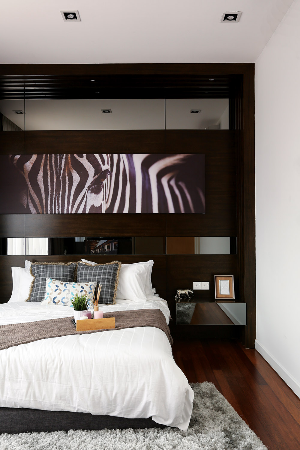
Charming Chambers: 5 Cosy Bedrooms with a Romantic Ambience
Friday, November 20, 2020
Decorating with your amore in mind? We combed through bedrooms throughout the country - and abroad, to rank the five coziest bedsteads for eliciting feelings of romance. Before the evening's events draw to a close and things inevitably lead back to the bedroom, be sure to have these decorative features in place to help your amorous ambitions along.
5. Monochromatic SimplicityMaking the most out of a few select trappings in their signature brand of monochromatic minimalism, Nu Infinity's arrangement speaks of wild passions: reflective panels frame a print of a zebra's patterns - strategically situated on the walls above the bed; a deep pile carpet in grey provides a comforting layer for bare feet to linger on; and a diminutive clutter tray adorned with the tools of aromatherapy provides the clearest signal of romantic intentions.
 Designer: Nu Infinity
4. Classically Feminine
Designer: Nu Infinity
4. Classically Feminine
Crisp, classically appointed architectural finishes and furnishings saturated in pale shades lend this bedroom a delicate and decidedly feminine elegance. The combination of daylight, or soft yellow lighting at night, help to bring out the tones of peaches and cream provided by the decorative wall treatments and fabrics. Amorous intentions are made clearer with the placement of a circular tub in view of the bed.
 Designer: S/Lab 10
3. Thoughtful Transition
Designer: S/Lab 10
3. Thoughtful Transition
The classical furnishings, intricate patterns in wallpaper, and exquisite lighting fixtures are the key elements in this bedroom helping to create an amorous vibe. A functional feature of special note is the thoughtful arrangement of seating around a coffee table equipped with refreshments to create an intimate space for romantic interludes.
 Designer: Hue Art Design
2. Exotic Excursion
Designer: Hue Art Design
2. Exotic Excursion
Conceived by interior designer, Nikki B, and situated within a gated community in Dubai, this bedroom exudes an exotic allure without resorting to the archetypal shades of romance. This intimate bedchamber in the desert presents decorative stone accents and elaborate fabrics in alternating swathes of blue and gold - the regional palette associated with luxury.
 Designer: Da Fonesca Design
1. Glamorous Detail
Designer: Da Fonesca Design
1. Glamorous Detail
This bedroom hits all the checkpoints in our list of things that make a bedroom exude romance: warm wood flooring contrasting against reflective accents on the walls, a circular bedstead displaying classical tendencies in the button-back upholstery, and just the right amount of shimmer in the materials.
 Designer: Gusto Design
Designer: Gusto Design
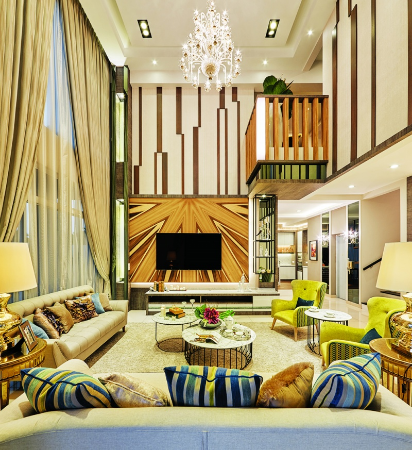
Luminous Elevations: How to Choose Lighting for Double-Height Living Rooms
Friday, November 20, 2020
The volume of air that comes with double-height ceilings typically calls for the use of impressive lighting fixtures that do more than just provide illumination - they inevitably become one of the focal points of attraction in living spaces. We combed through some delectable mansions, bungalows, duplexes, and penthouses to put this guide together and help you pick out the ideal chandelier (or other lighting fixture) to suit the extra-high ceiling of your décor.
Classical Chandeliers Equally appropriate in classical interiors as for lending an eccentric streak to modern settings, the many variations of glass or crystalline, and shaded or bare chandeliers are a requisite feature for anyone wanting a dependable style choice that can add a layer of elegance to a wide range of interiors.
 A classically inspired chandelier is a safe option to lend an aura of elegance to transitional or eclectic décors. Designer: The Roof
A classically inspired chandelier is a safe option to lend an aura of elegance to transitional or eclectic décors. Designer: The Roof
Curved Chandeliers A more common type of modern chandelier spotted in transitional and minimalist settings, the curved surfaces make for lower profile fixtures that do not intrude into the airspace. By virtue of their curved profiles and small size, many identical pieces can be hung together in staggered lines to depict heavenly bodies.
 Occupying less space than a conventional chandelier, the relatively small size of these metallic orbs enables the arrangement of multiple pieces in an array. Designer: Turn Design Interior
Occupying less space than a conventional chandelier, the relatively small size of these metallic orbs enables the arrangement of multiple pieces in an array. Designer: Turn Design Interior
Large-Scale Floor Lamps Take advantage of the abundance in ceiling space by incorporating an extra tall, floor-mounted lighting fixture. An imposing floor lamp represents an alternative focal point on an unanticipated plane and helps to preserve the volume of air provided by the high ceiling.
 The abundance of airspace in double-height spaces invites the use of over-sized floor mounted lighting fixtures. Designer: Turn Design Interior
The abundance of airspace in double-height spaces invites the use of over-sized floor mounted lighting fixtures. Designer: Turn Design Interior
Wall-Mounted Lights Maximize the conservation of airspace in your living room with low-profile lights mounted to walls. This arrangement can be used to highlight decorative walls higher up in the void while providing adequate task lighting and without hampering the intimate mood.
 Instead of an intrusive lighting fixture hanging in mid-air, this space presents discrete wall-mounted lights to produce an intimate atmosphere. Designer: IDS Interior
Instead of an intrusive lighting fixture hanging in mid-air, this space presents discrete wall-mounted lights to produce an intimate atmosphere. Designer: IDS Interior
Slim Spotlights If the dim illumination provided by wall-mounted lights is inadequate, or if you just want to highlight decorative furnishings nearer to the floor, consider using simple down-lights to obscure ceiling features in favour of highlighting furnishings on the ground.
 Pursuing a recording studio motif, this living room features utilitarian and low-profile down-lights to retain the sense of volume in this space. Designer: Motto Designs
Pursuing a recording studio motif, this living room features utilitarian and low-profile down-lights to retain the sense of volume in this space. Designer: Motto Designs
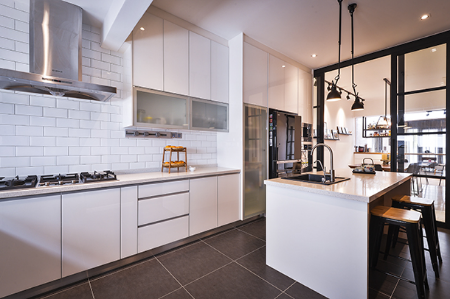
Galley Hues: Top 5 Colours for Your Kitchen
Friday, November 20, 2020
While white is a commonly used colour in kitchen spaces to maintain a clean atmosphere, some may want a little bit of a divergence with other colours from a neutral pallette to suit the rest of their home, or get a little bit creative with other colours to add some vibrance to their décor. Here, we take a look at the Top 5 colours for your kitchen.
 Designer: Yong Studio
Designer: Yong Studio
White Likely the most common pallete used for kitchens, the absence of colour contributes towards an immaculate atmosphere in kitchens with either modern or traditional stylings. The uniformity of white - stretching from ceilings, walls, backsplashes, countertops, cabinetry, and down to flooring makes these typically small areas of the home seem more spacious.
 Designer: Pocket Square
Designer: Pocket Square
Grey
The popularity of a using grey in kitchens emerged with the rise of the modern palette and granite countertops. The colour grey is most effective in a kitchen appointed with steel fixtures and reflective accents. Designer: GDY Design & Construction
Designer: GDY Design & Construction
Black Although typically confined to decorative accents, a kitchen is transformed into an inviting and elegant space when black is used as the base colour.
 Designer: Nu Infinity
Designer: Nu Infinity
Brown The natural shades of wood are ideal for both modern and country-styled kitchens, with darker shades creating a majestic effect and pale tones exuding a rustic flavour.
 Designer: Nu Infinity
Designer: Nu Infinity
Blue While pastel shades are associated with rustic interiors, modern kitchens can also benefit from the bespoke factor provided by saturation in a surprising hue of blue.
 Designer: Viincology
Designer: Viincology
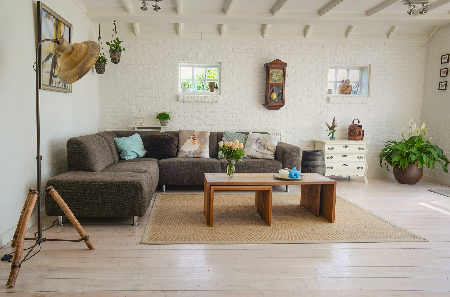
Zen Den: 8 Tips for Cultivating a Calm Atmosphere at Home
Friday, November 20, 2020
We spend many hours in our home. It’s where the day is started and sealed. It should be a place that fosters relief after the many to-dos and ventures of a day. Make the most of time at home by cultivating a relaxing, calm living space for yourself, your family, and your friends and guests. Whether in the living room, family room, bedroom, or other space, there are many small steps you can take to promote peace in the home. Follow these eight tips to transform home into a place you want to spend time in and relax in: 1. Give Everything a “Home” Having clutter on table tops, floors, and elsewhere can translate to feeling cluttered throughout your life. Make sure that your important things, like those needed on a daily basis (keys, for example), have a space that is easily accessible but not immediately visible. This will alleviate the sense of visual clutter. Keep doorways clear and items off and out of the spaces used for sitting and relaxing!
2. Set Atmosphere With Music
Having clutter on table tops, floors, and elsewhere can translate to feeling cluttered throughout your life. Make sure that your important things, like those needed on a daily basis (keys, for example), have a space that is easily accessible but not immediately visible. This will alleviate the sense of visual clutter. Keep doorways clear and items off and out of the spaces used for sitting and relaxing!
2. Set Atmosphere With Music
 Consider purchasing a portable speaker to connect to your phone, or set up a music streaming service on your TV for playing background music. Choose calming songs like instrumental soundtracks and classical pieces. Keep the sound low so you can hear the music but not too loud that people have to talk over the music.
3. Bring the Outdoors In
Consider purchasing a portable speaker to connect to your phone, or set up a music streaming service on your TV for playing background music. Choose calming songs like instrumental soundtracks and classical pieces. Keep the sound low so you can hear the music but not too loud that people have to talk over the music.
3. Bring the Outdoors In
 Bring vases of flowers or small plants inside. These provide color and calm. Choosing planters with decorative accents can improve the energy of a space as well. Live plants will clean the air and will not gather dust. The smell and life of indoor plants connects us with the outdoors, satisfying a fundamental human need for interaction with nature.
4. Let Light Shine
Bring vases of flowers or small plants inside. These provide color and calm. Choosing planters with decorative accents can improve the energy of a space as well. Live plants will clean the air and will not gather dust. The smell and life of indoor plants connects us with the outdoors, satisfying a fundamental human need for interaction with nature.
4. Let Light Shine
 Open windows, blinds, and drapes to permit sunlight to come in. Natural light will brighten the space, will help regulate hormones during the day, and will make the space feel bigger and cleaner, which has an instantly calming effect. Exposure to natural light is important for maintaining circadian rhythm, so allowing it into the home has health benefits. Reflective surfaces, such as mirrors and clean spaces, can make your space even brighter and feel bigger.
5. Freshen Up
Open windows, blinds, and drapes to permit sunlight to come in. Natural light will brighten the space, will help regulate hormones during the day, and will make the space feel bigger and cleaner, which has an instantly calming effect. Exposure to natural light is important for maintaining circadian rhythm, so allowing it into the home has health benefits. Reflective surfaces, such as mirrors and clean spaces, can make your space even brighter and feel bigger.
5. Freshen Up
 Consider opening windows to bring in natural air. Plug in light air fresheners or burn a scented candle to plant fresh smells inside. Essential oils, aromatherapy, or room sprays may also help temper the atmosphere. Use smells that have a calming or cleaning effect, such as lavender or lemon. Dusting down surfaces will help maintain a neat appearance.
6. Paint With Light or Neutral Colors
Consider opening windows to bring in natural air. Plug in light air fresheners or burn a scented candle to plant fresh smells inside. Essential oils, aromatherapy, or room sprays may also help temper the atmosphere. Use smells that have a calming or cleaning effect, such as lavender or lemon. Dusting down surfaces will help maintain a neat appearance.
6. Paint With Light or Neutral Colors
 Avoid bright statement walls or overly energizing colors like bright red and blue. Don't clutter walls with tons of pictures, photos, or frames. Instead, paint the walls with muted colors, neutral colors, or your favorite relaxing blend of colors. Leave the bright colors to accent pieces or items for display. Consider one or two larger focal pictures or an interesting piece of art to draw attention to a few central points in the room to avoid overstimulation.
7. Prepare for All Temperatures
Avoid bright statement walls or overly energizing colors like bright red and blue. Don't clutter walls with tons of pictures, photos, or frames. Instead, paint the walls with muted colors, neutral colors, or your favorite relaxing blend of colors. Leave the bright colors to accent pieces or items for display. Consider one or two larger focal pictures or an interesting piece of art to draw attention to a few central points in the room to avoid overstimulation.
7. Prepare for All Temperatures
 Have pillows and blankets available for snuggling up on your favorite couch or chair. Have a couple blankets for warmth and ensure that they have different thicknesses and textures so you have "just right" warmth no matter the weather or room temperature. Blanket and pillows are also great for providing texture in the home and can add a sense of calming aesthetic interest wherever they are displayed.
8. Keep Your Favorite Things in View
Have pillows and blankets available for snuggling up on your favorite couch or chair. Have a couple blankets for warmth and ensure that they have different thicknesses and textures so you have "just right" warmth no matter the weather or room temperature. Blanket and pillows are also great for providing texture in the home and can add a sense of calming aesthetic interest wherever they are displayed.
8. Keep Your Favorite Things in View
 While it is typically good to avoid overcrowding a space, having your favorite books, magazines, or photos out of the things you love and favorite memories can add positivity and comfort to the room. Keep out only those keepsakes that have special value to you. Use these to keep you calm during your relaxing time, refresh your memories, or motivate you for your next adventure.
Consider these steps as you clean and renovate your home. Keeping your space calm and reflective of your values and personality will transform your home into a place of restoration and peace, which is the best possible effect it could have!
Article courtesy of Olivia Warfield, a contributing writer and media relations specialist for Atlas Heating & Air Service. She writes for a variety of DIY and lifestyle blogs.
While it is typically good to avoid overcrowding a space, having your favorite books, magazines, or photos out of the things you love and favorite memories can add positivity and comfort to the room. Keep out only those keepsakes that have special value to you. Use these to keep you calm during your relaxing time, refresh your memories, or motivate you for your next adventure.
Consider these steps as you clean and renovate your home. Keeping your space calm and reflective of your values and personality will transform your home into a place of restoration and peace, which is the best possible effect it could have!
Article courtesy of Olivia Warfield, a contributing writer and media relations specialist for Atlas Heating & Air Service. She writes for a variety of DIY and lifestyle blogs.

Silent Nights, Pretty Lights: Lighting Ideas for a Bright and Festive Ambience at Home
Friday, November 20, 2020
Enhance the Christmas mood at home with these beautiful lighting ideas that add a spark of joy in every corner.
Create a focal point at your dining table by using an attractive pendant light accompanied by festive centrepieces beneath it. Choose a colour theme - for instance gold to bring on a touch of elegance. (Image credit: Luxxu)

Minimalist-looking lighting works well when paired with festive decoration. (Image credit: Boca do Lobo)

Whether you pop one up in your porch, on feature walls or at entryways, mounted wall lights with a festive theme easily infuse homes with a Christmas ambience. (Image credit: Lights4fun)

Decorate a corner with Xmas features. To enhance the look, hang fairy lights across the wall and brighten the space up with candlelight. (Image credit: Lights4fun)
More Christmas decorating tips here.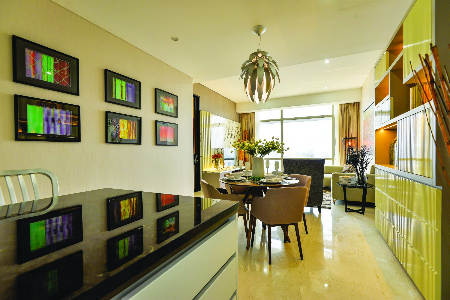
10 Ideas for Combining Your Dining and Living Spaces
Friday, November 20, 2020
Beyond just arranging dining and living room furniture sets near each other, there are a host of other considerations that one should look into when combining these two functionally separate areas.
 Interior design by: Kuzoj
Interior design by: Kuzoj
With space at a premium in urban homes, combining two of the areas that often take up the most space is a practical way of freeing up room for other functions. But things can get a little busy and cluttered when combining dining and living areas in small spaces such as a studio apartment or a home with an open floor plan. In light of the many ways that this merging can be achieved, we took a look at the most notable combined spaces we have seen over the years and extracted the base ingredients for your perusal here.
1. Grouped Arrangements
If you have the space to spare in your open plan home, the easiest way to combine the dining room with seating lounge is to position the respective furniture into two separate but adjacent groups - with an empty gap for a walkway between the two groups providing a means of access and to act as subtle demarcation.
 Interior design by: SQFT Space Design Management
Interior design by: SQFT Space Design Management
2. Narrow Spaces
For a comfortable dining experience, diners need between 90cm to 1.3m of space to be able to pull out a chair and take a seat, with around 60cm to 70cm of space between each seat for adequate elbow room. If space is limited, opt for a narrow rectangular table to discretely occupy the space on one side of the seating lounge.
 Interior design by: Pocket Square
Interior design by: Pocket Square
3. Informal Seating
At the most extreme end of the scale, one could also go beyond merging dining and living areas, by having seating and dining table occupy the same space. Replacing chairs on one side of a dining table with an upholstered bench creates a casual setting for meals and enables one to forgo having a sofa set - if the comfort and formality are not to be missed.
 Interior design by: The Roof
Interior design by: The Roof
4. Wall Features
To rein in the surplus empty space in your open plan layout, build up false wall projections and turn them into shelving or see-through niches to provide a means of visual separation as well as a functional fixture for additional storage.
 Interior design by: Beata Home and Office Furnishing
Interior design by: Beata Home and Office Furnishing
5. Decorative Ceilings
Even the thinnest of wall façades will take up some space, if only a negligible amount. To clearly demarcate your combined dining and seating lounge without occupying any of the valuable floor space, consider forming borders on the ceilings to visually indicate the extents of the functionally separate areas.
 Interior design by: Design Base
Interior design by: Design Base
6. Island Bars
Even without a dry kitchen adjacent to the seating lounge, it is possible to incorporate bar-height counters or kitchen islands - along with some stools or chairs of appropriate height, to provide a dining space in close proximity. Opting for countertop dining makes for a casual dining experience, and frees up additional space for other uses, such as a more spacious seating lounge.
 Interior design by: Pins Studio
Interior design by: Pins Studio
 Interior design by: Luna Solutions
Interior design by: Luna Solutions
7. Raised Platforms
With a small measure of additional space in an open floor plan, a slightly raised wooden platform would serve to elevate, highlight, and to keep the dining space visually distinct from any nearby seating.
 Interior design by: Pins Studio
Interior design by: Pins Studio
8. Decorative Archways
Building up a decorative archway between dining and seating furniture is another space-efficient way of define the combined areas, but best results are achieved in wide spaces so as not to make the open floor plan appear cramped.
 Interior design by: D'Concepto Design
Interior design by: D'Concepto Design
9. Dividing Drapery
In lieu of features such as arches, shelving, or see-through niches, an opaque or transparent curtain can be drawn shut to provide a temporary privacy screen during meals, and opened between meals to preserve the spaciousness of the open layout.
 Interior design by: Zids Design
Interior design by: Zids Design
10. Unifying Style
Whatever the means you have chosen to apply in visually indicating the separate functions of your combined dining and seating area, a harmoniously applied decorative style will serve to unify the distinct spaces. A unifying style does not necessarily entail a repeated palette, as a cohesive décor can still be achieved with complementary colour pairs applied as interchangeable base and accent colours.
 Interior design by: Nu Infinity
Interior design by: Nu Infinity

Christmas Centrepiece: How To Create a Festive Centrepiece for Your Dining Table
Friday, November 20, 2020
If you find yourself wondering how to make your spaces more festive this Christmas, consider using centrepieces to enliven your dining table. Here are a few simple ways to whip up a good-looking decor piece for your tables.
Fabrics A decorative tapestry such as oriental table runners or a simple cloth serves to underscore centrepiece arrangements with a layer of texture and to protect dining surfaces from scratches. Anything as overt as plain fabrics dyed in red or green to tartan and plaid textiles in subtle colours will evoke the Christmas spirit in varying degrees.
 Image Source
Image Source
Thematic Decorations As with fabrics, decorative objects can be as obvious as cut branches of red European holly (Ilex aquifolium), snowflakes in crystal, and figurines depicting the requisite characters of the season - or as understated as pine cones and a variety of edible berries.
 Image Source
Image Source
Silverware Associated with prosperous clan gatherings during the holiday season, the reflective sheen of silverware conjures impressions of snow-covered landscapes. As food will inevitably be found scattered over dining surfaces - often before the whole family even sits down for dinner, consider integrating silver-gilded containers of edibles or beverages into centrepiece arrangements.
 Image Source
Image Source
Glassware Glassware and other crystalline decorations can be used as an alternative to silver containers to add some shine to centrepieces. Glassware such as snack bowls and beverage pitchers, or thematic crystalline decorative objects are best appreciated in direct light to add a measure of intricate elegance to the centrepiece.

Lighting Candles and accent lighting can applied adequate lighting for diners as well as be part of your centrepiece arrangements while maintaining an intimate mood. Turn up narrow downlights directly over centrepieces to heighten metallic and crystalline decorations and improve task lighting with a scattering of tea candles or paraffin lamps.
 More Xmas decor tips for every room in the house here. For timeless centrepiece decor for dining tables, check out this article.
More Xmas decor tips for every room in the house here. For timeless centrepiece decor for dining tables, check out this article.

Centre of Attention: 7 Centrepiece Ideas for Your Dining Table
Friday, November 20, 2020
If you have just finished adjusting your dining table and meticulously arranging it in place in your home, only to have that nagging feeling that the décor is somehow incomplete, it is because the space needs a centrepiece.
You could do as one does and just let clutter accumulate just to see what happens, the random assortment of items will eventually speak of your personality and lifestyle, but it may not blend well with the rest of the space - that and most would regard that as an unintended mess. We let our panel of decorators into our homes to help us figure out centrepieces, and arrived at the following Top 7 ideas that will help you get ahead of the curve by tailoring your dining table decorations to suit your interior and to project the ambiance you design.
 Designer: Konan Design
Designer: Konan Design
7. Classic Candlelight The original dining table centrepiece - the archetypal candle and candle-holder combination has been a pervasive decorative element, providing a form of lighting especially suited for intimate moods, and appearing in everything from classical art to modern fine dining experiences. Candle-holders serve as pieces of art in themselves, ranging from ostentatious candelabra gilded in precious metals to utilitarian glassware.
 Designer: SQFT Space Design Management
Designer: SQFT Space Design Management
6. Edible Art Food invariably gets left on the dining table in some way or another - especially with large households in constant flux, where mealtimes tend to overlap. Embrace the familial chaos while encouraging healthy eating by displaying brightly coloured fruit or snacks in attractive containers to provide an additional decorative element. To take it a step further, unleash the inner epicurean and artist by experimenting with pickled or dried edibles in jars to produce a few splashes of colour.
 Designer: Surface R Interior Design
Designer: Surface R Interior Design
5. Rotating Trays A mainstay of oriental-styled interiors, the turntable - known in some circles as the "Lazy Susan", is a rotating tray made of wood or stone. Typically found in the centre of large Chinese dinners, the turntable adds a functional and elegant layer to round dining tables that serves equally well as a pedestal for art or dining accessories - while providing diners with Arthurian access to the dishes placed on it.
 Designer: Jashen Interior Design
Designer: Jashen Interior Design
4. Sculptures On the other end of the function-form spectrum are gratuitous objects of art to inject some glam and glitter into a scene and turn a dining table into a display space. A curated sculpture with interesting reliefs on all sides provides luxurious views from any angle in combination with a rotating tray.
 Designer: Gusto Design
Designer: Gusto Design
3. Literary Pursuits In lieu of spending the time combing galleries and markets for "that ideal piece", go the way of the literary artist by shaping an impromptu sculpture out of books to accent a loft-like décor. Especially in small spaces where coffee table space is scarce, books that were intended for the seating lounge can be piled up on the dining table instead, freeing up living room space and providing a set of spontaneous talking points while dining.
 Designer: M Innovative Builders
Designer: M Innovative Builders
2. Living Embellishments A simple and immediately rewarding centrepiece element comes from our own lush backyards. All that is needed is a few stalks of freshly-cut flowers, or sprigs of herbs, thrown into a container - anything from an old tea tin to an intricate glass vase would do the job. While these living centrepieces can only be expected to last little more than a few days, an extra "wow" could be elicited with a contained ecosystem of live fish and water plants in the centre of the dining table.
 Designer: Q1 Interior
Designer: Q1 Interior
1. Clutter Trays To keep that assortment of decorative and functional items in check, consider using a tray in wood or metal to neatly present dining table accessories, and to add another layer of texture to dining surfaces. Aside from the obvious practical application, clutter trays can also be used to frame other decorative elements, or even create a mini Zen garden with appropriately deep trays filled with sand.
 Designer: X-Two Concept
If you haven't already, click here to take a look at our definitive guide for selecting the right kind of dining table to suit your interior.
Designer: X-Two Concept
If you haven't already, click here to take a look at our definitive guide for selecting the right kind of dining table to suit your interior.

Choosing Your Living Room Furniture
Friday, November 20, 2020
Before setting out on your journey of acquiring living room furniture, consider the function, size, orientation, and shape of the space - then the style, material, and colour of your furnishings.
Filling any blank canvas requires the poise and confidence of an accomplished artist, but there is so much more than one's creative pride at stake when it comes to the kind of space that imparts first impressions like the average living room does. There are minimalist furnishings that may render a large space empty, there are button-backed leather Chesterfields that can overwhelm an urban apartment, and then there are modern contemporary sofas that seem to fit anywhere.
 Image Credit: Design Base
Image Credit: Design Base
With all the available sizes and styles of furnishings available, you may find yourself hard pressed to assemble a cohesive arrangement with varied pieces from different manufacturers. Armed with this guide and the critical considerations it presents, we believe your next search for living room furniture will produce more effective results.
Function
The first thing to do before furnishing any space is to pose the question of what one intends to do with it. Is your home a hub for large clan gatherings or more likely reserved for a select few? The approaches to furnishing your living room would differ depending on whether you are assembling a bachelor pad hangout or a lounge for a large family - the latter typically requires more seating, including the requisite pair of matching armchairs for the matriarch and patriarch of the clan, while the former could be adequately furnished with a single sofa set in close proximity to a coffee table.
 Interior design by: Q1 Interior Concept
Interior design by: Q1 Interior Concept
Size
With the role of the living room decided, one would have to take a look at what space there is to work with. In addition to floor space, one should also consider the presence and height of walls demarcating the area. First of all, is the lounge part of an open plan concept or is it enclosed in walls? A room surrounded by walls limits ingress and egress options, making arrangements more dependant on the placement of walls - on the other hand, an open layout leaves more to the imagination.
 Interior design by: The Home Concept Furniture
Interior design by: The Home Concept Furniture
Secondly, does the height of the ceiling make for a double volume space? A double-height ceiling will enable the incorporation of furnishings with high profiles to take advantage of the extra airspace, while a conventional ceiling may require furnishings of lower height so as to not overwhelm the sense of volume.
Lastly, what is the traffic flow around the house going to look like? If the living room is located more at the core of the house, walkways between furnishings would have to be considered, less so if it is a secluded corner.
 Interior design by: The Roof Studio
Interior design by: The Roof Studio
Shape
In addition to the size of the living room, the shape of a space will have an effect on the furnishings you select. An especially long and narrow lounge may not benefit from many round furnishings placed in the centre, while a square room will appear rather empty with the majority of furnishings hugging the walls.
 Interior design by: ID Industries
Interior design by: ID Industries
There exists a number appearing in both natural and produced designs that have been found to be aesthetically pleasing since the Italian Renaissance - the golden ratio of 1.618 has often been used to produce compositions that are universally regarded as beautiful. Applying this ratio to your own compositions will almost certainly guarantee an appealing arrangement: if you have an especially long space, consider visually subdividing it with pieces of seating or table surfaces to achieve a space where the length divided by width produces a number approaching the golden ratio.
Orientation
Another factor with significant weight on the effect of your furnishings is the orientation of the space, which affects the amount of sunlight your living room receives as the sun transits across the sky during the day. Material choices for your furnishings could be swayed by varying levels of sunlight at different times of day, so we recommend keeping a few sample swatches around to compare before settling on a material. Coupled with the consideration of natural lighting is the presence of windows providing scenic views - furnishings with low profiles may be considered to preserve the view, while high-backed seating could be made less intrusive by being positioned against a wall.
 Interior design by: The Roof Studio
Interior design by: The Roof Studio
Style
Prior considerations with regard to the function, size, shape, and orientation of the living room are less controllable - but the choice of style for your furnishings is where your personality will be more obviously presented. Before settling on your choice of furnishings, decide on whether you want your living room to be dedicated to the hallmarks of particular styles, such as the traditional trappings of classical style or dispense with all the frills for a minimalist decor - or maybe you would want to consider putting together your own unique assembly to present a more eccentric image.
 Interior design by: The Home Concept Furniture
Interior design by: The Home Concept Furniture
Materials
The choice of material for your furnishing is largely dependant on the function of the space, the lighting levels, and the style you want to achieve. Metal and wood frames are compatible with a wide range of styles, with reflective surfaces being more suited for spaces with a modern lean. Suede and fabric upholstery may be delectable to the senses, but tougher materials like leather may be more suitable in homes with children or pets.
 Interior design by: Surface R
Interior design by: Surface R
Colour
It probably goes without saying that the shades and tones of your living room furniture should be selected according to your personal preference, albeit with attention paid to the subtle effects of colour on moods, the appearance of colours in changing light conditions, and matching or complementing furnishings with the base or accent colours in architectural finishes.
 Interior design by: X-Two Concept
Interior design by: X-Two Concept
Completely saturating a room in various shades of a single colour is an easy way to get around most of the additional considerations of matching or complementing with base or accent colours, while imposing into a space a favoured hue and its effects on mood.
 Interior design by: Gusto Design & Build
Interior design by: Gusto Design & Build





